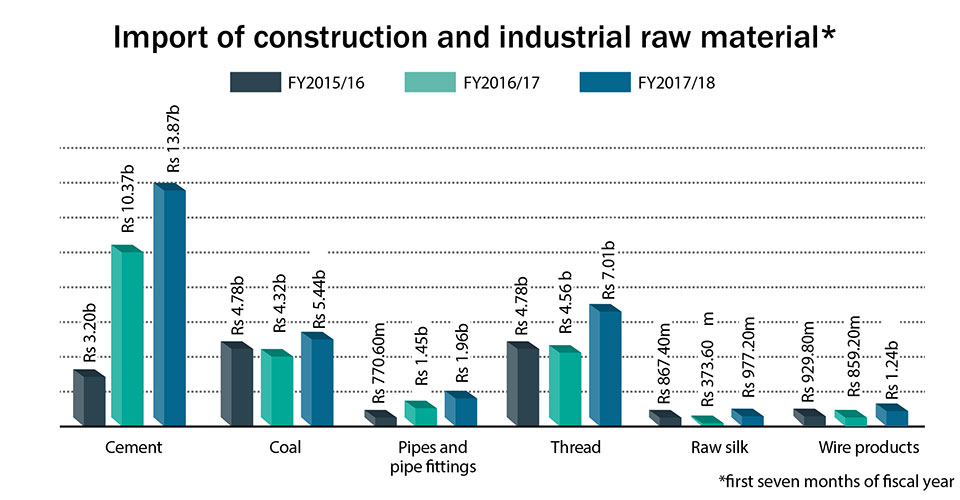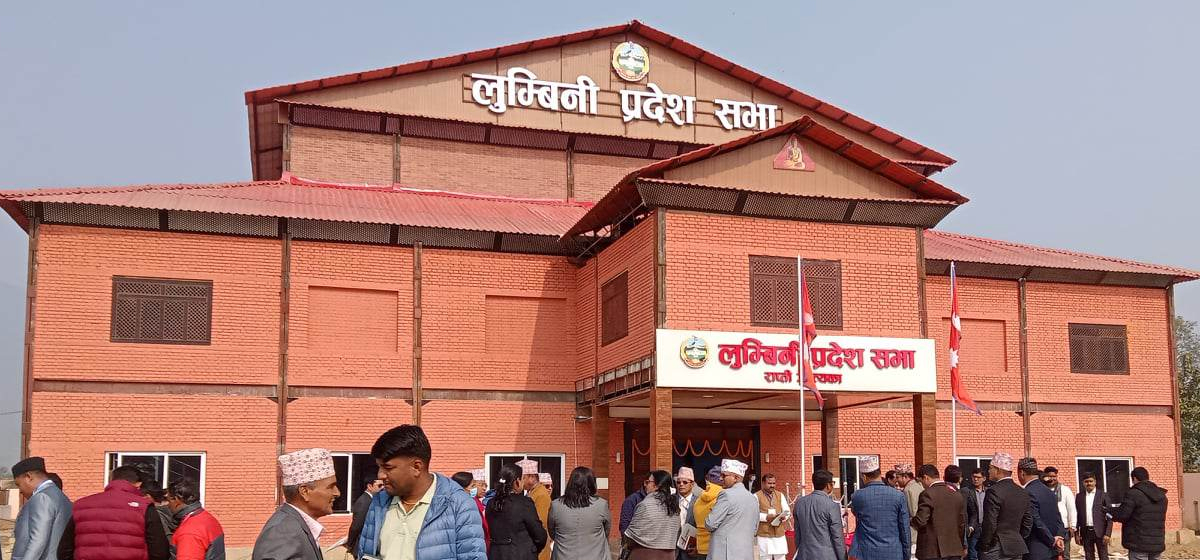
OR
Rising imports show robust growth in construction sector
Published On: March 21, 2018 08:59 AM NPT By: Ayam Shrestha

KATHMANDU, March 21: There has been a steep rise in import of construction materials and industrial raw materials over the past two years. This indicates the construction and man ufacturing sector of the nation has at least been vibrant. A report published by Nepal Rastra Bank (NRB) suggests that the import of these materials has increased by more than double in the past two years.
The import of the said materials in the review period soared to Rs 286.5 billion in FY2016/17 increasing by 86.4 percent from Rs 153.8 billion in the previous year. This year, according to the report, construction and industrial raw material worth Rs 322 billion was imported to the country, which is 12.4 percent more than that in the first seven months of FY2016/17 and a staggering 109.4 percent more than that in FY2015/16.
The import of Bitumen has increased by nearly 47 times in the first seven months of FY2017/18 as compared to that of FY2015/16. FY2016/17 saw an increase in the import of this product used in black-topping of roads by 17 times as the import jumped from Rs 22.9 million to Rs 389 million. This year, the import of Bitumen further saw a leap by 175.5 percent increasing to nearly Rs 1.07 billion.
The import of steel rods and sheets has seen a stunning increase by more than 24 times in the past two years. While it increased from Rs 26.2 million in the first seven months of FY2015/16 to Rs 564.4 million increasing by nearly 22 times, this increased by 11.8 percent as compared to last year reaching Rs 631 million in FY2017/18.
The import of cement has seen a rise by more than four times within the past two years. The first seven months of FY2016/17 saw increase by more than three times as the import of cement rose from Rs 3.2 billion to Rs 10.04 billion. Increasing by 33.8 percent, the import of cement rose to Rs 13.87 billion in the first seven months of FY2017/18
Although the first seven months of the current fiscal year saw a dip in the import of coal by 9.5 percent dropping to Rs 4.3 billion in FY2016/17 from Rs 4.77 billion in FY2015/16, it has shown signs of rise lately. The first seven months of the current fiscal year saw a rise by more than a fifth as compared to FY2016/17 and nearly 14 percent as compared to FY2015/16 to Rs 5.44 billion. Coal is used in steel and metal industries in furnace and by large hotels as fuel for baking.
Similar to the trend seen in the import of coal, although the import of threads to the country fell by nearly five percent on FY2016/17 as it fell from Rs 4.78 billion to Rs 4.55 billion. There has been a rise by nearly 54 percent on the first seven months of the current fiscal year as its import crossed Rs 7 billion. Tread coming from India and across the globe fuels the garment industry of the country.
Plumbing is always involved when building modern infrastructures and to complete transfer of various fluids, pipes and fittings are necessary. The import of pipes and fittings has increased by 154.4 percent over the past two years as it increased by 87.7 percent between FY2015/16 and FY2016/17 and by another 35.5 percent in the first seven months of FY2017/18. From Rs 770.6 million in the first seven months of FY2015/16, it increased to nearly Rs 1.45 billion in that period last year. The import of pipes and fittings hovers around Rs 1.96 billion in the review period, this year.
Raw silk that has been an important ingredient for pashmina products has also seen a rise in import by 161.6 percent in the past seven months of FY2017/18 as compared to the previous year. Although silk import plummeted by nearly 63 percent in FY2016/17 dropping from Rs 864.4 million to Rs 373.6 million, it has increased greatly to Rs 977.2 million this year.
The past two years has seen an increasing trend for the import of GI wire that is an important construction material at various sites. The import of GI wire jumped from Rs 0.5 million to Rs 2 million, increasing fourfold. This in the past year increased by nearly 30 percent increasing from Rs 0.4 million.
Following a dip by 7.6 percent in the import of copper plates and wire products between FY2015/16 and FY2016/17, the import of wires has risen by 44.1 percent as it reached Rs 1.2 billion this year from Rs 859.2 million last year and Rs 929.8 million in the year before during the review period. Copper is used as a conductor of electricity when it comes to wire while sheets of copper is also used to make handicrafts.
Economists claim that such dramatic increase in the import of construction and industrial raw materials is due to the increased construction work and the growth in the manufacturing sector of the nation.
Speaking with Republica, economist Keshav Acharya stated: "These imports shows positive direction as construction sector is growing and industrial productions are increasing."
Likewise, reinforcing Acharya's speculation is the Macroeconomic and Financial Report published by NRB which reads, "An uptick in foreign direct investment has ramped up the construction of hydropower projects and production of cement. On top of these factors, the completion of elections and the formation of governments in all three sectors have created a congenial environment for private sector investment."
You May Like This

Govt to focus on industrial, agri sector to achieve 8% growth target
KATHMANDU, May 31: The government is anticipating a massive industrial and agricultural expansion this year as it has set growth target... Read More...

Slow remittance growth puts pressure on external sector stability
KATHMANDU, Nov 22: Remittance growth is on a decline for the past few months, raising concerns that slow growth of money... Read More...

Easy, cheaper loans key to sustaining growth rate: Pvt sector
KATHMANDU, June 20: Private sector leaders have said that the monetary policy for the coming fiscal year 2017/18 should address the... Read More...



Just In
- Rautahat traders call for extended night market hours amid summer heat
- Resignation of JSP minister rejected in Lumbini province
- Russia warns NATO nuclear facilities in Poland could become military target
- 16th Five Year Plan: Govt unveils 40 goals for prosperity (with full list)
- SC hearing on fake Bhutanese refugees case involving ex-deputy PM Rayamajhi today
- Clash erupts between police and agitating locals in Dhanusha, nine tear gas shells fired
- Abducted Mishra rescued after eight hours, six arrested
- Forest fire destroys 13 houses in Khotang















Leave A Comment